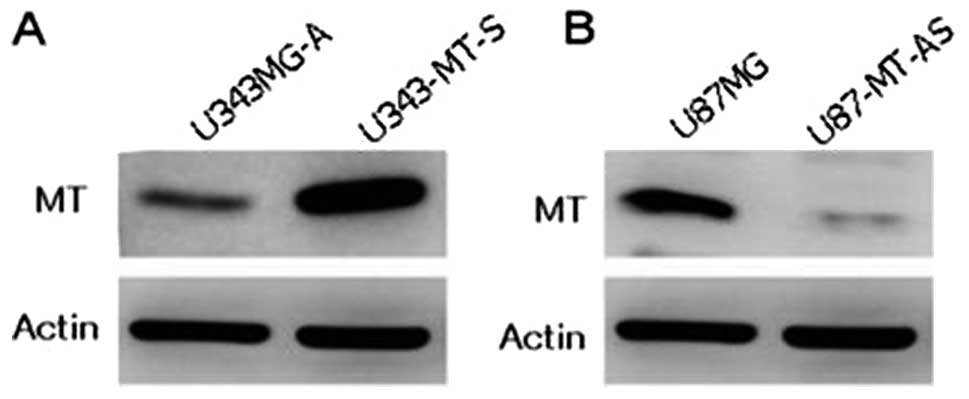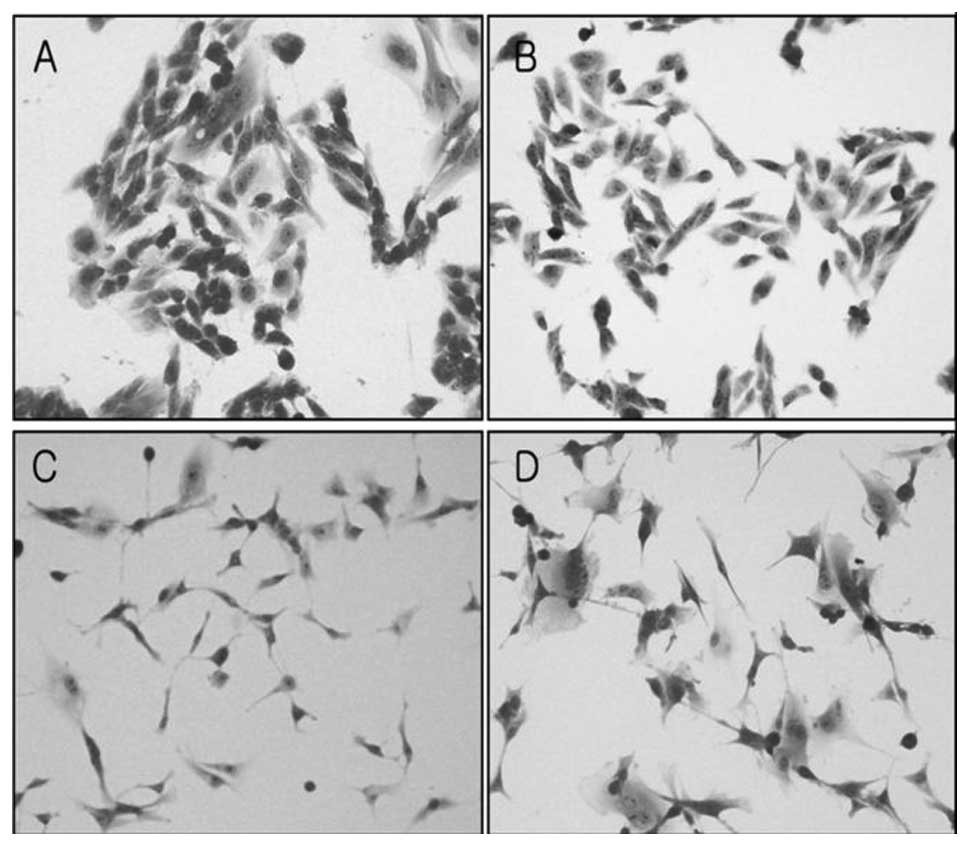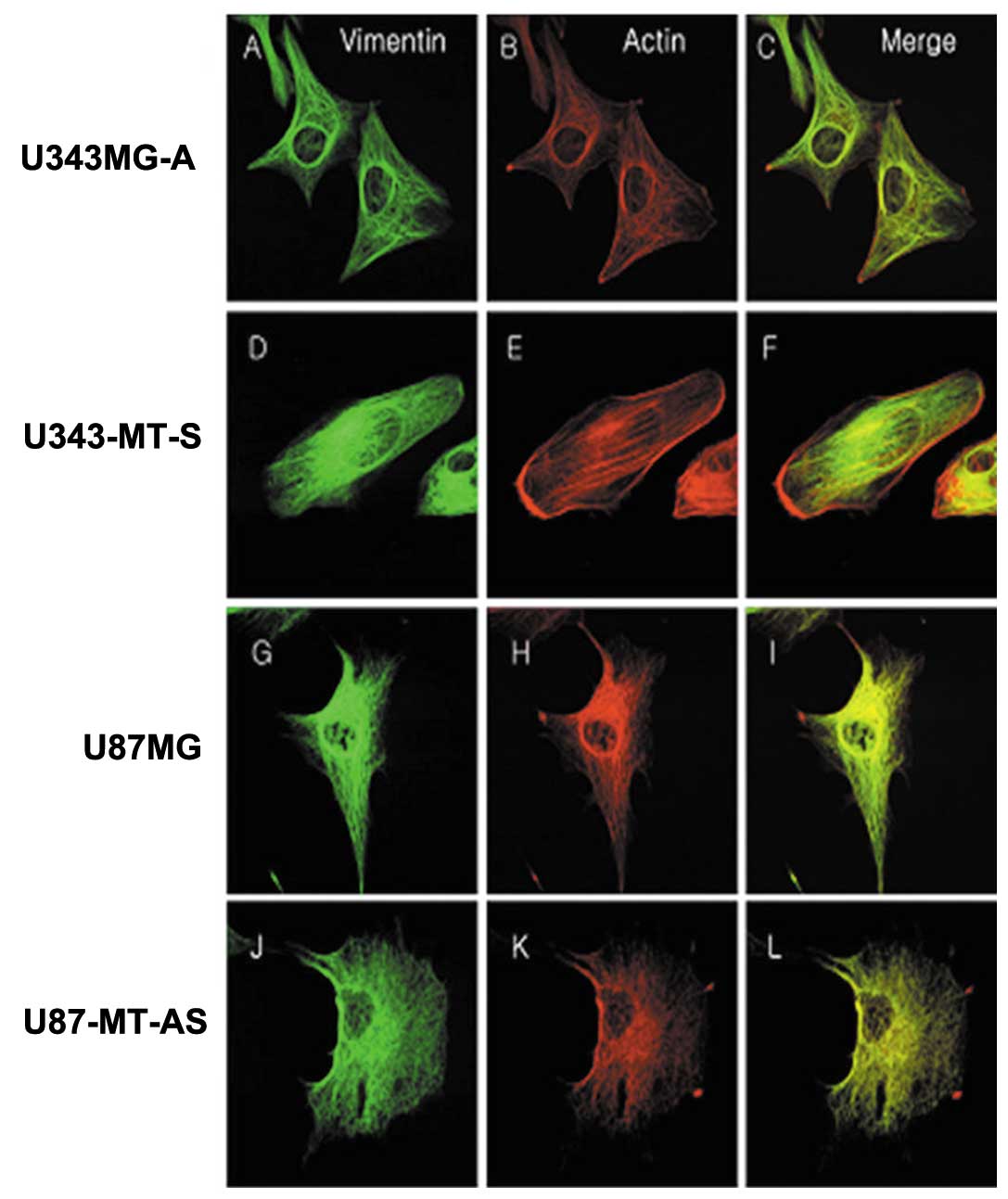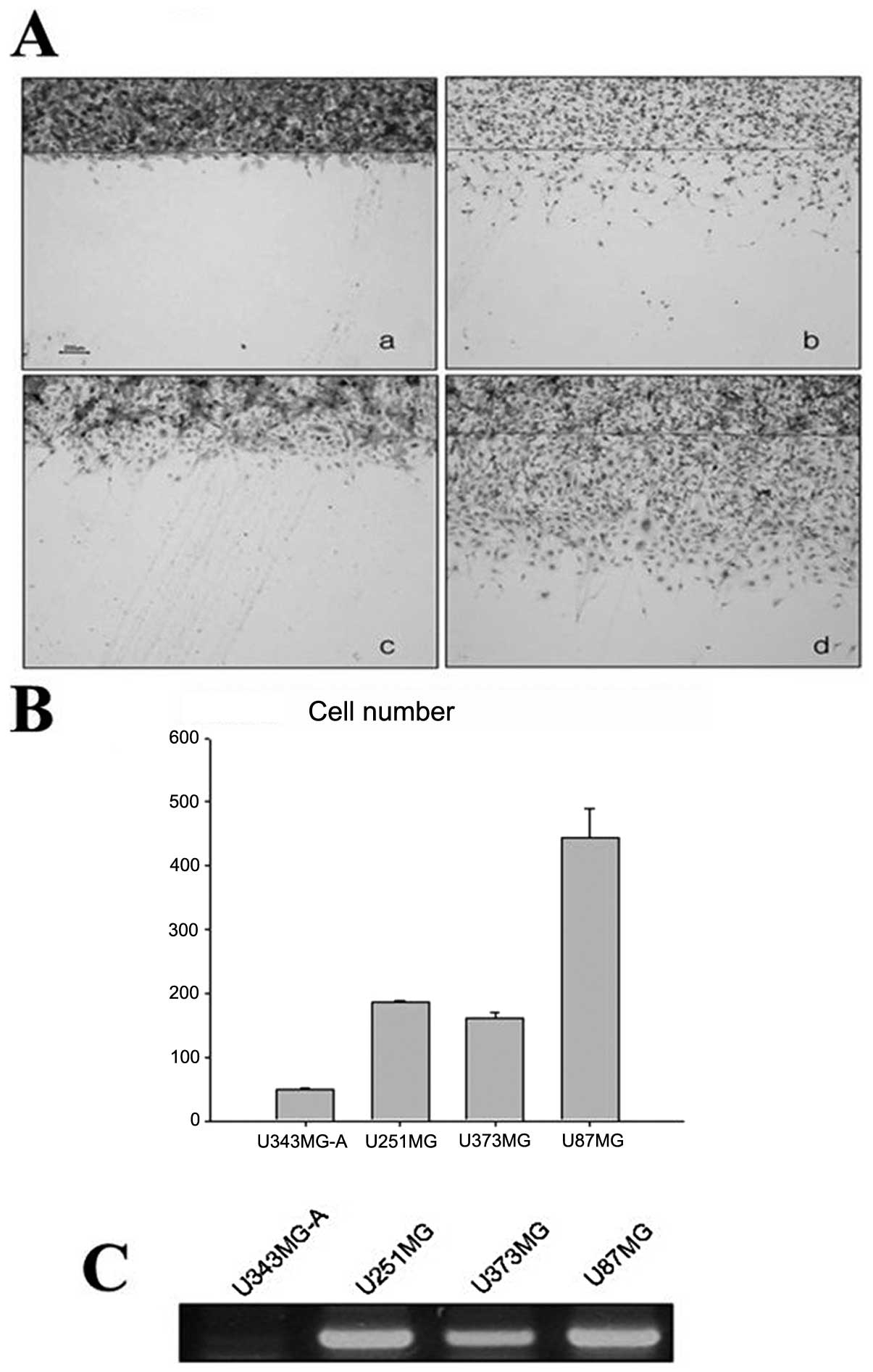|
1
|
Kassis J, Lauffenburger DA, Turner T and
Wells A: Tumor invasion as dysregulated cell motility. Semin Cancer
Biol. 11:105–117. 2001. View Article : Google Scholar : PubMed/NCBI
|
|
2
|
Mariani L, McDonough WS, Hoelzinger DB,
Beaudry C, Kaczmarek E, Coons SW, Giese A, Moghaddam M, Seiler RW
and Berens ME: Identification and validation of P311 as a
glioblastoma invasion gene using laser capture microdissection.
Cancer Res. 61:4190–4196. 2001.PubMed/NCBI
|
|
3
|
Coffey DS: Prostate cancer metastasis:
talking the walk. Nat Med. 2:1305–1306. 1996. View Article : Google Scholar : PubMed/NCBI
|
|
4
|
Levine MD, Liotta LA and Stracke ML:
Stimulation and regulation of tumor cell motility in invasion and
metastasis. EXS. 74:157–179. 1995.PubMed/NCBI
|
|
5
|
Kim YJ, Kwak CI, Gu YY, Hwang IT and Chun
JY: Annealing control primer system for identification of
differentially expressed genes on agarose gels. Biotechniques.
36:424–430. 2004.PubMed/NCBI
|
|
6
|
Ryu HH, Jung S, Sun HS, Jung TY, Jin SG,
Jin YH, Kim IY, Jeong YI and Kang SS: Screening for
motility-associated genes in malignant astrocytoma cell lines. J
Neurooncol. 82:125–131. 2007. View Article : Google Scholar : PubMed/NCBI
|
|
7
|
Cai L and Cherian MG: Zinc-metallothionein
protects from DNA damage induced by radiation better than
glutathione and copper- or cadmium-metallothioneins. Toxicol Lett.
136:193–198. 2003. View Article : Google Scholar : PubMed/NCBI
|
|
8
|
Ebadi M, Leuschen MP, el Refaey H, Hamada
FM and Rojas P: The antioxidant properties of zinc and
metallothionein. Neurochem Int. 29:159–166. 1996. View Article : Google Scholar : PubMed/NCBI
|
|
9
|
Kelley SL, Basu A, Teicher BA, Hacker MP,
Hamer DH and Lazo JS: Overexpression of metallothionein confers
resistance to anticancer drugs. Science. 241:1813–1815. 1988.
View Article : Google Scholar : PubMed/NCBI
|
|
10
|
Roesijadi G: Metal transfer as a mechanism
for metallothionein-mediated metal detoxification. Cell Mol Biol
(Noisy-le-grand). 46:393–405. 2000.PubMed/NCBI
|
|
11
|
Satoh M, Cherian MG, Imura N and Shimizu
H: Modulation of resistance to anticancer drugs by inhibition of
metallothionein synthesis. Cancer Res. 54:5255–5257.
1994.PubMed/NCBI
|
|
12
|
Maret W, Jacob C, Vallee BL and Fischer
EH: Inhibitory sites in enzymes: zinc removal and reactivation by
thionein. Proc Natl Acad Sci USA. 96:1936–1940. 1999. View Article : Google Scholar : PubMed/NCBI
|
|
13
|
Meplan C, Richard MJ and Hainaut P:
Metalloregulation of the tumor suppressor protein p53: zinc
mediates the renaturation of p53 after exposure to metal chelators
in vitro and in intact cells. Oncogene. 19:5227–5236. 2000.
View Article : Google Scholar : PubMed/NCBI
|
|
14
|
Jayasurya A, Bay BH, Yap WM and Tan NG:
Correlation of metallothionein expression with apoptosis in
nasopharyngeal carcinoma. Br J Cancer. 82:1198–1203.
2000.PubMed/NCBI
|
|
15
|
Nagel WW and Vallee BL: Cell cycle
regulation of metallothionein in human colonic cancer cells. Proc
Natl Acad Sci USA. 92:579–583. 1995. View Article : Google Scholar : PubMed/NCBI
|
|
16
|
Ghosh S, May MJ and Kopp EB: NF-kappa B
and Rel proteins: evolutionarily conserved mediators of immune
responses. Annu Rev Immunol. 16:225–260. 1998. View Article : Google Scholar : PubMed/NCBI
|
|
17
|
Andela VB, Gordon AH, Zotalis G, Rosier
RN, Goater JJ, Lewis GD, Schwarz EM, Puzas JE and O’Keefe RJ:
NFkappaB: a pivotal transcription factor in prostate cancer
metastasis to bone. Clin Orthop Relat Res. S75–S85. 2003.
View Article : Google Scholar : PubMed/NCBI
|
|
18
|
Baldwin AS: Control of oncogenesis and
cancer therapy resistance by the transcription factor NF-kappaB. J
Clin Invest. 107:241–246. 2001. View
Article : Google Scholar : PubMed/NCBI
|
|
19
|
Karin M, Cao Y, Greten FR and Li ZW:
NF-kappaB in cancer: from innocent bystander to major culprit. Nat
Rev Cancer. 2:301–310. 2002. View
Article : Google Scholar : PubMed/NCBI
|
|
20
|
Butcher HL, Kennette WA, Collins O, Zalups
RK and Koropatnick J: Metallothionein mediates the level and
activity of nuclear factor kappa B in murine fibroblasts. J
Pharmacol Exp Ther. 310:589–598. 2004. View Article : Google Scholar : PubMed/NCBI
|
|
21
|
Kim CH, Kim JH, Lee J and Ahn YS:
Zinc-induced NF-kappaB inhibition can be modulated by changes in
the intracellular metallothionein level. Toxicol Appl Pharmacol.
190:189–196. 2003. View Article : Google Scholar : PubMed/NCBI
|
|
22
|
Nakajima M and Chop AM: Tumor invasion and
extracellular matrix degradative enzymes: regulation of activity by
organ factors. Semin Cancer Biol. 2:115–127. 1991.PubMed/NCBI
|
|
23
|
Hiura T, Khalid H, Yamashita H, Tokunaga
Y, Yasunaga A and Shibata S: Immunohistochemical analysis of
metallothionein in astrocytic tumors in relation to tumor grade,
proliferative potential, and survival. Cancer. 83:2361–2369. 1998.
View Article : Google Scholar : PubMed/NCBI
|
|
24
|
Maier H, Jones C, Jasani B, Ofner D,
Zelger B, Schmid KW and Budka H: Metallothionein overexpression in
human brain tumours. Acta Neuropathol. 94:599–604. 1997. View Article : Google Scholar : PubMed/NCBI
|
|
25
|
Gallicchio LM, Flaws JA, Fowler BA and
Ioffe OB: Metallothionein expression in invasive and in situ breast
carcinomas. Cancer Detect Prev. 29:332–337. 2005. View Article : Google Scholar : PubMed/NCBI
|
|
26
|
Jin R, Bay BH, Chow VT and Tan PH:
Metallothionein 1F mRNA expression correlates with histological
grade in breast carcinoma. Breast Cancer Res Treat. 66:265–272.
2001. View Article : Google Scholar : PubMed/NCBI
|
|
27
|
Winge DR: Limited proteolysis of
metallothioneins. Methods Enzymol. 205:438–447. 1991. View Article : Google Scholar : PubMed/NCBI
|
|
28
|
Florianczyk B: Copper and metallothioneins
in cancer cells. Ann Univ Mariae Curie Sklodowska Med. 58:390–393.
2003.PubMed/NCBI
|
|
29
|
Nartey NO, Banerjee D and Cherian MG:
Immunohistochemical localization of metallothionein in cell nucleus
and cytoplasm of fetal human liver and kidney and its changes
during development. Pathology. 19:233–238. 1987. View Article : Google Scholar : PubMed/NCBI
|
|
30
|
Sato M and Bremner I: Oxygen free radicals
and metallothionein. Free Radic Biol Med. 14:325–337. 1993.
View Article : Google Scholar : PubMed/NCBI
|
|
31
|
Cherian MG, Jayasurya A and Bay BH:
Metallothioneins in human tumors and potential roles in
carcinogenesis. Mutat Res. 533:201–209. 2003. View Article : Google Scholar : PubMed/NCBI
|
|
32
|
Shimoda R, Achanzar WE, Qu W, Nagamine T,
Takagi H, Mori M and Waalkes MP: Metallothionein is a potential
negative regulator of apoptosis. Toxicol Sci. 73:294–300. 2003.
View Article : Google Scholar : PubMed/NCBI
|
|
33
|
Zeng J, Vallee BL and Kagi JH: Zinc
transfer from transcription factor IIIA fingers to thionein
clusters. Proc Natl Acad Sci USA. 88:9984–9988. 1991. View Article : Google Scholar : PubMed/NCBI
|
|
34
|
Yamamoto Y and Gaynor RB: Therapeutic
potential of inhibition of the NF-kappaB pathway in the treatment
of inflammation and cancer. J Clin Invest. 107:135–142. 2001.
View Article : Google Scholar : PubMed/NCBI
|
|
35
|
Zangger K, Oz G, Haslinger E, Kunert O and
Armitage IM: Nitric oxide selectively releases metals from the
amino-terminal domain of metallothioneins: potential role at
inflammatory sites. FASEB J. 15:1303–1305. 2001.PubMed/NCBI
|
|
36
|
Coyle P, Philcox JC, Carey LC and Rofe AM:
Metallothionein: the multipurpose protein. Cell Mol Life Sci.
59:627–647. 2002. View Article : Google Scholar : PubMed/NCBI
|
|
37
|
Kanekiyo M, Itoh N, Kawasaki A, Tanaka J,
Nakanishi T and Tanaka K: Zinc-induced activation of the human
cytomegalovirus major immediate-early promoter is mediated by
metallothionein and nuclear factor-kappaB. Toxicol Appl Pharmacol.
173:146–153. 2001. View Article : Google Scholar : PubMed/NCBI
|
|
38
|
Miyamoto H, Altuwaijri S, Cai Y, Messing
EM and Chang C: Inhibition of the Akt, cyclooxygenase-2, and matrix
metalloproteinase-9 pathways in combination with androgen
deprivation therapy: potential therapeutic approaches for prostate
cancer. Mol Carcinog. 44:1–10. 2005. View Article : Google Scholar
|
|
39
|
Abdel-Mageed AB and Agrawal KC: Activation
of nuclear factor kappaB: potential role in
metallothionein-mediated mitogenic response. Cancer Res.
58:2335–2338. 1998.PubMed/NCBI
|
|
40
|
Haga A, Nagase H, Kito H and Sato T:
Enhanced invasiveness of tumour cells after host exposure to heavy
metals. Eur J Cancer. 32A:2342–2347. 1996. View Article : Google Scholar : PubMed/NCBI
|
|
41
|
Kim HG, Kim JY, Han EH, Hwang YP, Choi JH,
Park BH and Jeong HG: Metallothionein-2A overexpression increases
the expression of matrix metalloproteinase-9 and invasion of breast
caner cells. FEBS Lett. 585:421–428. 2011. View Article : Google Scholar : PubMed/NCBI
|


















